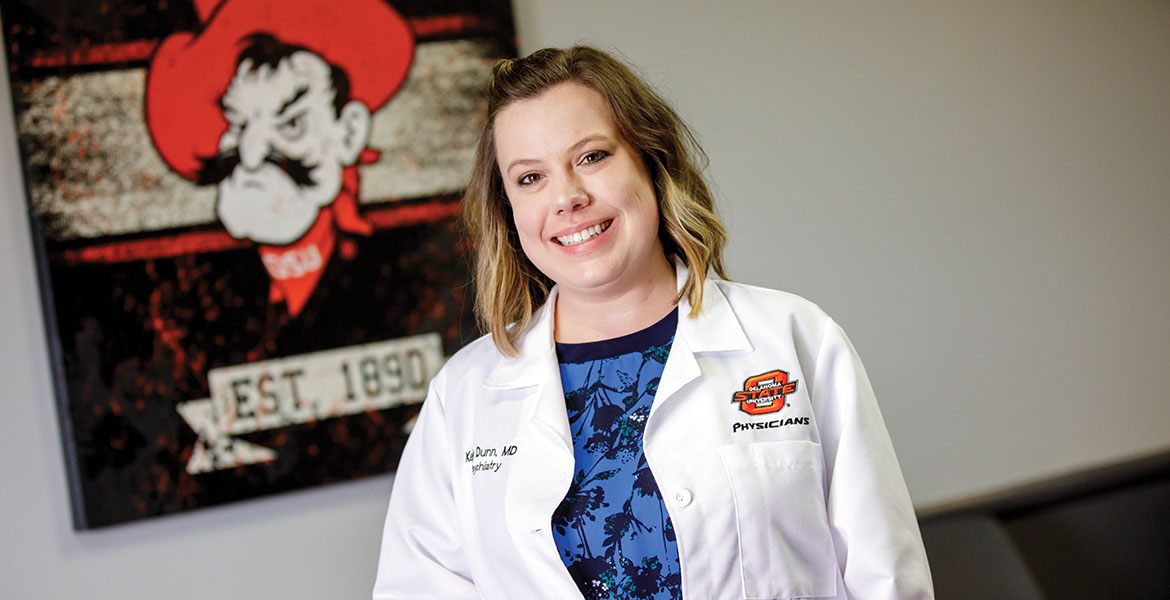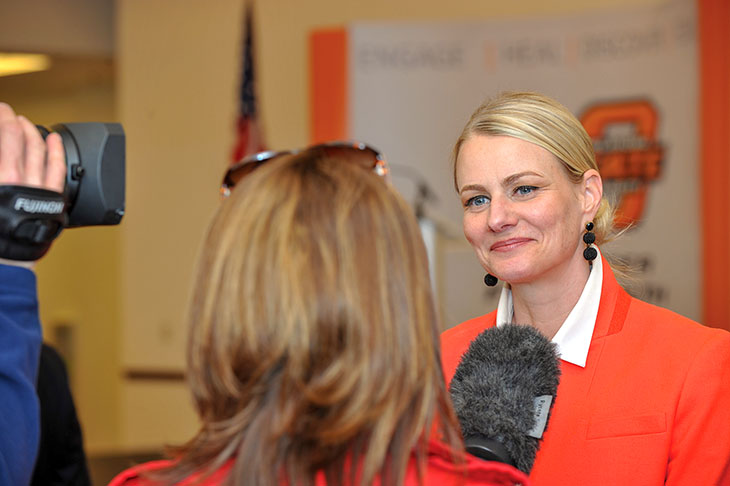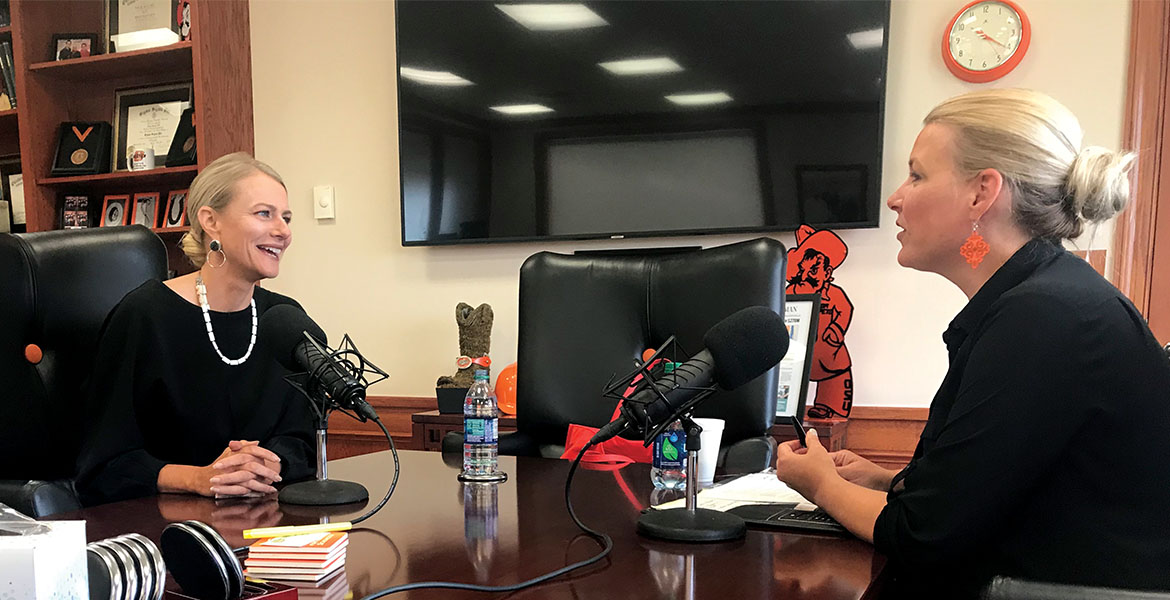
Treating Addiction
Thursday, August 29, 2019
Oklahoma’s Purdue Pharma settlement gives OSU-CHS more resources to treat patients, train physicians and tackle the opioid crisis nationwide
There is no typical day for Dr. Kelly Dunn, an assistant clinical professor and physician
at the OSU Addiction Medicine
Clinic in Tulsa.
“I don’t have a typical patient, either. We see young adults to people in their 50s and 60s,” Dunn said. “Addiction is very indiscriminating. It can affect anyone.”
The vast majority of patients with an opioid addiction started out with a prescription they received after an injury or a procedure, Dunn said. “They like the way it feels, the euphoria after they take it,” she said. “Then they’re continually chasing a higher dose because of the tolerance they build up.”
But the picture many may have of what someone with an opioid addiction looks like rarely matches the reality.
“One of my patients is a young woman who just got married and bought her first new car. Another patient is a working mother in her 40s,” Dunn said. “You would never be able to pick them out as substance abuse patients. Most of my patients, you couldn’t tell. A lot of people suffer in secret.”
THE ORIGINS
Several factors in the health care industry collided about 20 years ago to create today’s opioid addiction epidemic.
A one-paragraph letter to the editor published in 1980 in the New England Journal of Medicine suggested that addiction was rare in patients using narcotics. That one paragraph became widely cited evidence that opioids were non-addictive, said Julie Croff, Ph.D. and executive director of the OSU Center for Wellness & Recovery.
| Well Content |
|---|
|
WHAT IS AN OPIOID? |
“We now know that at five days of using a prescription opioid, the risk of addiction goes up, and if taken for 30 days, the risk of addiction and being on those pills a year later is at 40 percent,” she said.
In the mid-1990s, pain became one of the vital signs of health, and physicians were urged to treat pain as a tenet of practicing medicine. At the same time, pharmaceutical companies were advertising the benefits of opioids to health care providers and releasing new formulations.
“Doctors were advised by professional societies in the last two decades that it was unethical to not treat patients’ pain. The result is that the opioid epidemic is akin to the bubonic plague of the 17th century or the HIV/AIDS crisis of the 1980s — it is the plague of today,” said Jason Beaman, D.O., chair of OSU-CHS’ Department of Psychiatry and Behavioral Sciences and director of training and education for the Center for Wellness & Recovery.
| Well Content |
|---|
| HOSPITALIZATIONS In 2018,, MORE THAN 3,000 OKLAHOMANS were admitted to a hospital for a non-fatal overdose, and 80 percent of those involved a prescription opioid medication. |
FIGHTING BACK
In November 2017, OSU Center for Health Sciences President Kayse Shrum, D.O., established the OSU Center for Wellness & Recovery to address the opioid epidemic plaguing Oklahoma. Less than a year later, the OSU Addiction Medicine Clinic opened in partnership with 12&12, a Tulsa-based nonprofit residential addiction treatment and counseling center.

The addiction clinic offers patients comprehensive outpatient treatment options and services that incorporate both medical and mental health treatments in order to give them the best chance at recovery, Dunn said.
More than two years ago, Oklahoma Attorney General Mike Hunter sued several pharmaceutical
companies, claiming the effect
of deceptive marketing campaigns over the last decade fueled the state’s opioid crisis.
In March,
a $270 million settlement between the state and Purdue Pharma was reached, with $197.5
million of that settlement earmarked to establish an endowment at the Center for Wellness
& Recovery that will create a national center and foundation for opioid addiction
treatment and research as well as a national scientific advisory board.
“The addiction crisis facing our state and nation is a clear and present danger. Deploying the money from this settlement immediately allows us to decisively treat addiction illness and save lives,” Hunter said. “This endowment will allow the university to expand its footprint to a national level to combat the crisis. I have full faith and confidence in Dr. Kayse Shrum and her team to lead this initiative.”
EDUCATION FIRST
As part of OSU-CHS, the Center for Wellness & Recovery follows the institution’s osteopathic philosophy of holistic medicine. The center addresses pain and addiction through four main pillars: training and education, clinical practice, advocacy, and research.
Treating addiction starts with educating the public, patients and physicians.
“When I was in medical school people weren’t talking about it yet. I didn’t get any specific training. It’s slowly becoming a part of medical education, including educating physicians,” said Dunn, who graduated from the University of Oklahoma College of Medicine in 2014.
As a national average, medical students receive between two and eight hours of education about addiction, but OSU-CHS goes far beyond that. Since 2015, all second-year medical students take an additional 16 hours of instruction time and can complete clinical rotations at 12&12.
Dr. Sam Martin, director of addiction medicine, said OSU-CHS’ focus and attention to addiction medicine is what brought him here in 2016.
“Oklahoma has been one of the hardest-hit states in the opioid epidemic. There are more Oklahoma adults between 25 and 64 dying of unintentional prescription drug overdoses than in car crashes,” Martin said. “OSU College of Osteopathic Medicine recognizes addiction for the health crisis that it is. Our medical students not only learn about addiction in the classroom, but then they have this opportunity to see its cause and effect and treatment first-hand.”
In 2018, OSU Medicine received approval to offer a one-year fellowship in addiction medicine that rotates through the addiction clinic and inpatient units at 12&12.
| Well Content |
|---|
| DEATHS NEARLY 50 PERCENT of Oklahoma’s drug overdose deaths in 2018 were attributed to a pharmaceutical drug. |
“We believe that we have a responsibility to prepare future physicians to recognize the signs and symptoms of addiction and to provide patients with the answers and help they need to seek recovery,” Beaman said. “Great strides against addiction can be made by educating future doctors about the disease.”
The Center for Wellness & Recovery also provides continuing medical education courses to physicians as well as public workshops and presentations covering a variety of addiction topics. This fall, the center will host the Addiction Medicine Conference and Board Review Course, a five-day conference for practicing physicians.
Center staff and physicians are also working with strategic partners on several research initiatives dealing with alternative treatment options and predictive models.
“Further understanding that addiction is a brain disease and how we best treat and prevent addiction is the overall goal for our research. We have to better understand how addiction starts, and if there are ways to interrupt it,” Croff said. “We know one cause of opioid addiction has been pain — both physical and emotional. We have to find new and better ways to treat pain in order to prevent addiction to opioids.”
| Well Content |
|---|
| DOSING The CDC recommends a first opioid prescription be for less than seven days and under 50 morphine milligram equivalents. Anything longer or higher is considered long duration and high dose. In 2017, ONLY 36 PERCENT of Oklahoma Blue Cross Blue Shield members received first prescriptions that met those CDC guidelines. |
SPENDING WISELY
Following the settlement with Purdue Pharma in March, an endowment was created at the center that will be used for treating the ongoing opioid addiction epidemic nationwide.
The endowment received an initial $102.5 million from the settlement and beginning in January, another annual payment of $15 million for five years. During that same five-year period, the endowment will also receive ongoing contributions of addiction treatment medicine valued at $20 million.
“The mission of the OSU Center for Wellness & Recovery is to save lives and rescue those who are struggling with addiction. This endowment will allow us to assist communities in Oklahoma and across the country that have been ravaged by the opioid epidemic with innovative approaches to addressing this health crisis,” Shrum said. “Now we will have the resources to create a place where people can come together to engage in meaningful initiatives to prevent, treat and eradicate this horrible disease.”
The center has primarily been funded through a combination of federal and private funds. The injection of endowment funds gives it resources that can be used more broadly in clinical practice and research.
“We were honored to be selected to receive these funds. It is a huge testament to the work started at OSU-CHS before the Center for Wellness & Recovery was formally created and what the CWR has been able to accomplish in a short amount of time,” Croff said. “It is our goal to continue to pursue cutting-edge training, clinical services, research, prevention and advocacy in the area of addiction medicine.”
| Well Content |
|---|
| PILLS In 2016, enough opioids were prescribed in Oklahoma FOR EVERY ADULT HERE TO HAVE MORE THAN 100 PILLS. |
Dunn, who works directly with patients, said resources are needed the most in prevention, training in addiction medicine, and increasing the number of treatment and recovery programs and facilities.
“Right now, when someone is ready to seek treatment, they have to go through an intake process and then they’re put on a waiting list. There’s just not room for them. That’s something I hope the funds can help with,” she said.
| Well Content |
|---|
| PAPER In 2017, Oklahoma was one of the top opioid-prescribing states, writing 88.1 prescriptions per 100 people. That’s 3.44 MILLION OPIOID PRESCRIPTIONS for a population of 3.933 million. |
Ultimately, this settlement will affect everyone in the state in some way because addiction isn’t just an individual disease — it affects families and communities.
“It means hope for a better tomorrow. Our communities and families have been plagued by an epidemic of addiction. CWR will help families and patients find hope in recovery,” Croff said. “We will create best practices that protect our communities in the future. We will partner to heal the damage of this epidemic. We will continue to be a part of the work of communities across the state and this settlement provides us the means to continue that work.”

